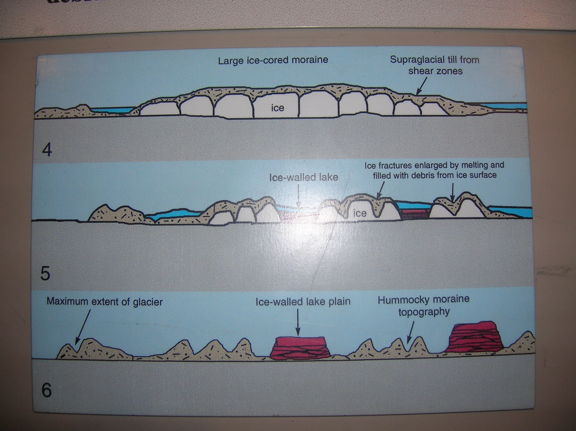Ice-Walled Lakes
Across a vast region of the Saginaw Impact's ejecta field, we see the sand being deposited on top of the Wisconsinian Glaciation ice sheet. The blanket was draped comfortably over all pre-existing landforms, including the ice sheet itself. Considering the expected insulation such a blanket would have created, the creation of the ice walled plains seem quite probable.
The ejecta is seen as a stratum of coarsely skewed clastic sand and gravel, turbulently deposited so as to present an unstratified, hummocky, highly compacted single unit, although re-working as the ice beneath wasted would be expected. The stratum would present a number of other challenging characteristics to those who examine it. Most apparent would be the total lack of terrigeneous detritus within the deposit. Neither marine, nor eolian, nor fluvial. Quite a challenge, regardless of any glacial retreat regimen discord.
Our primary focus is on the Carolina bay landforms, and we have comfortably correlated those structures in the east and midwest with an impact into the Saginaw area of Michigan. While similar "Carolina bay" shallow elliptical basin structures we are proposing may well have been created above the ice sheet at the moment of deposition, we have little expectation that they would persist through the process of de-glaciation. The debris blanket would, however, provide an insulating layer which may have delayed the melting of the burried ice for thousands of years. In addition, the natural "basin" structure we propose to be created in the depositional layer would immediately encourage the formation of an ice walled (and floored) lake.

One possible outcome may have been the creation of "Ice-Walled Lakes", seen today across this very same landscape.
An intriguing presentation was made by John W. Attig, et al, entitield Ice-Walled-Lake Plains In The Mid-Continent—What They Tell Us About Late Glacial Ice-Marginal Processes And Environments, at the GSA North-Central Section - 37th Annual Meeting, March 24–25, 2003. Here is the abstract:
A published paper from this same group is entitled Ice-walled-lake plains: Implications for the origin of hummocky glacial topography in middle North America , which was authored by Lee Clayton, J. Attig and others: doi:10.1016/j.geomorph.2007.02.045
An informative graphic is provided in a web based presentation by Chris Below of the Univerisity of Wisconsin at Eau Claire, and linked to a larger version:



